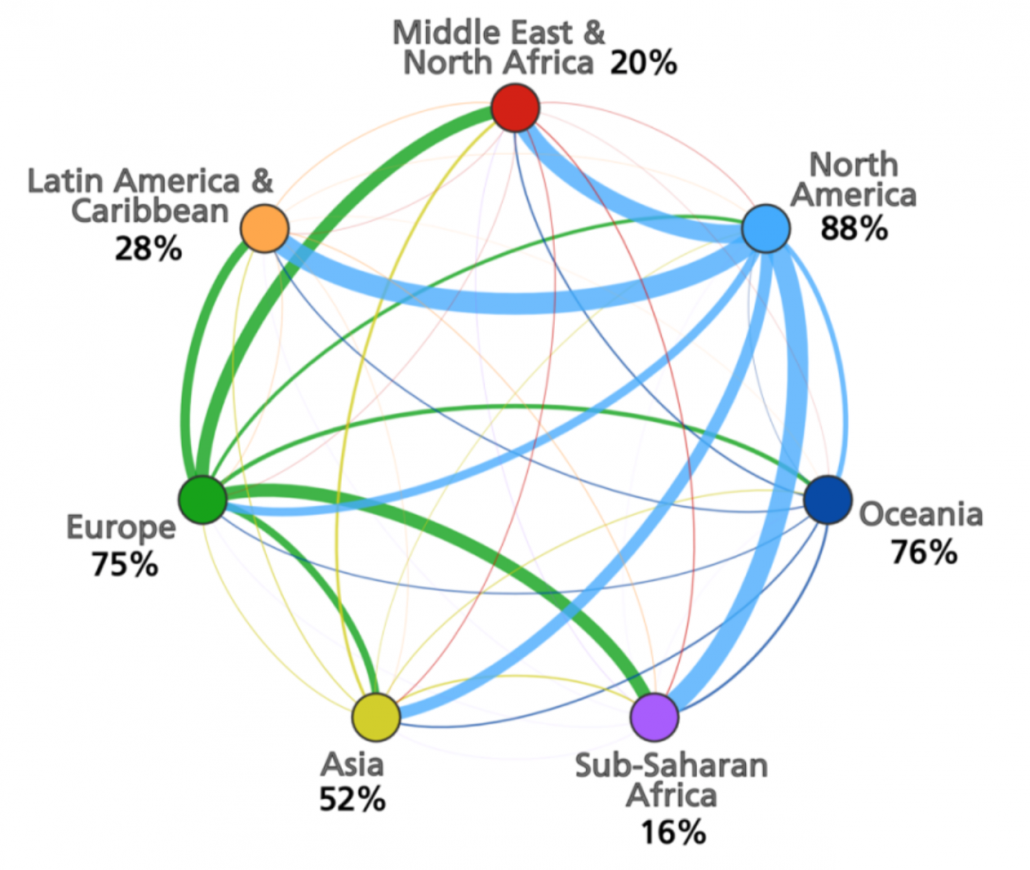
Network of Wikipedia edits between world regions, normalised for each target region. The edges are coloured according to the source region. Percentages denote self-edits (not depicted).
I am very happy to announce that a new paper that I have written with Ralph Straumann and Bernie Hogan is now available:
Graham, M., Straumann, R., Hogan, B. 2015. Digital Divisions of Labour and Informational Magnetism: Mapping Participation in Wikipedia. Annals of the Association of American Geographers. 105(6) 1158-1178. doi:10.1080/00045608.2015.1072791.(pre-publication version here)
The paper is the result of about three years of research into geographic patterns of participation in Wikipedia. We sought to ask what the geographies of voice and representation are: with a focus on whether Wikipedia offers people in the world’s economic margins a space to represent their own communities, or whether those margins continue to represented by non-locals. The full abstract is below. I have also previously blogged about some of the results in more detail in the following posts:
Explaining locally-contributed content in Wikipedia about Sub-Saharan Africa
Visualising the locality of participation and voice on Wikipedia
Digging deeper into the localness of participation in Sub-Saharan African Wikipedia content
Informational Magnetism on Wikipedia: geographic networks of edits
Informational Magnetism on Wikipedia: mapping edit focus
Abstract:
There are now more than 3 billion Internet users on our planet. The connections afforded to all of those people, in theory, allow for an unprecedented amount of communication and public participation. The goal of this article is to examine how those potentials match up to actual patterns of participation. By focusing on Wikipedia, the world’s largest and most used repository of user-generated content, we are able to gain important insights into the geographies of voice and participation. This article shows that the relative democratization of the Internet has not brought about a concurrent democratization of voice and participation. Despite the fact that it is widely used around the world, Wikipedia is characterized by highly uneven geographies of participation. The goal of highlighting these inequalities is not to suggest that they are insurmountable. Our regression analysis shows that the availability of broadband is a clear factor in the propensity of people to participate on Wikipedia. The relationship is not a linear one, though. As a country approaches levels of connectivity above about 450,000 broadband Internet connections, the ability of broadband access to positively affect participation keeps increasing. Complicating this issue is the fact that participation from the world’s economic peripheries tends to focus on editing about the world’s cores rather than their own local regions. These results ultimately point to an informational magnetism that is cast by the world’s economic cores, virtuous and vicious cycles that make it difficult to reconfigure networks and hierarchies of knowledge production.
Note that much of this work comes from the following report:
- Graham, M., and Hogan, B. 2014. Uneven Openness: Barriers to MENA Representation on Wikipedia. Oxford Internet Institute Report, Oxford UK.
The following paper also offers some related results:
- Graham, M., Hogan, B., Straumann, R. K., and Medhat, A. 2014 Uneven Geographies of User-Generated Information: Patterns of Increasing Informational Poverty Annals of the Association of American Geographers (forthcoming).
Or for a broader discussion about why the locality of participation matters, see:
- Graham, M. 2014. Internet Geographies: Data Shadows and Digital Divisions of Labour. In Society and the Internet: How Networks of Information and Communication are Changing our Lives, eds M. Graham and W. H. Dutton. Oxford: Oxford University Press. 99-116.
- Graham, M., M. Zook, and A. Boulton. 2013. Augmented Reality in the Urban Environment.Transactions of the Institute of British Geographers. 38(3) 464-479.